Features of training
It’s worth noting right away that you need to gain strength and patience, since this process very rarely goes quickly.
In general, cats are quite clean creatures, although they are often capricious, but they are very sensitive to the issue of toileting.
They usually choose hard-to-reach corners as an ideal place to defecate, so during the period of getting to know the new home, it is advisable to close all the spaces under the furniture so that the cat does not get through there.
Some people mistakenly believe that training an adult pet is much easier than training a kitten, but this is not at all true.
Each animal has special character traits, in particular adults, who have already formed and developed certain habits regarding going to the toilet.
A cat that has lived on the street for some time is accustomed to doing its business literally under every bush and in other corners inaccessible to prying eyes.
The first and most important point is the installation location of the tray.
It should be easily accessible, but at the same time isolated so that the cat can retire there. A corner in the bathroom or on a warm balcony is perfect. For obvious reasons, it is not worth placing the tray in the passage corridor, and especially in the kitchen.
If this is a full-fledged house with walls and a roof, an exception can be made.
During the first time your cat is in the house, it is better to keep him in a closed room to avoid the temptation to mark new territory.
Tray space
Since it is easier to accustom one-month-old kittens to a tray than two-month-old ones, this same tray should appear in your apartment at the same time as the small pet.
But the toilet must be in a certain place and you will have to choose the corner with special care.
By the way, at the same time it is recommended to start making a scratching post , which will help avoid troubles in the form of damaged furniture and wallpaper.
Each representative of the cat family is individual, with its own character and temperament.
And if in most cases it is possible to accustom a street kitten to a litter box quite quickly, since he is used to defiantly relieving himself, then with some people from elite nurseries it is not so simple.
For example, if you bought a Scottish or British kitten , then he may turn out to be very shy.
It will be possible to accustom him to the toilet only if it is located in some secluded place.
And sometimes you even have to purchase a closed toilet .
So, the most suitable place will meet the following conditions:
- silence - away from the refrigerator and other appliances that make noise during operation;
- not on the aisle, preferably in a corner - this could be a place under the bathroom or a corner in any room or corridor;
- The tray should always be freely accessible - not behind a closed door and not in the narrowest corner under the bathroom, where the kitten will not fit.
You need to spend as much time searching for a suitable place as the animal needs.
Otherwise, you may not be able to train your kitten to go to the litter box.
This article will tell you how to remove the smell of cat urine /
If he finds the angle you have chosen inconvenient, he will continue to shit all over the apartment.
Choosing a tray and filler
You need to select a suitable container based on the size of the cat so that it can safely dig there. The height of the side can be different and the higher it is, the better, but 10 cm is considered the golden mean.
If the pet has previously had owners, you can ask them which litter box the pet went to.
You can purchase a full-fledged house in which the cat can retire and be in its comfort zone. Such trays have both an advantage in the form of built-in absorbent filters and a disadvantage in the difficulty of caring for them.
The most common and budget-friendly are ordinary plastic boxes; the same ones, but with an insert mesh at the bottom, are a little more expensive.
Which type is right for a particular cat can only be determined through trial and error.
A very important role is played by filler, of which there are many types on the shelves of pet stores.
It can be wood filling made from compressed sawdust, clumping, absorbent, mineral, silica gel or made from cellulose waste.
Here it is worth making a choice based on the recommendations of friends or veterinarians, the type of filler and its cost.
Trial and error will also allow you to find exactly what suits your cat.
By the way, some pets prefer either no filler at all, or pieces of newspaper placed on the bottom.
However, such options are not entirely hygienic, since the cat’s paws can play the role of filler here, which will constantly get dirty.
Training - Basics
If a kitten is only a month old, then at that age it is extremely rare to train it to go to a litter tray without litter .
Veterinarians advise starting the training process with a toilet, which will have something with which the animal can cover its excrement.
The filler can be either pressed wood shavings or mineral lumps of clay, or ordinary newspaper, torn into small fragments.
It is better, of course, to use a tray with a professional filler that can absorb unpleasant odors and liquid feces
Thus, you can quickly accustom any kitten to the tray, street, Scottish or British, it doesn’t matter, the main thing is that its paws and fur will always be clean and dry.
So, the baby is a month old or 1.5 months old, we purchased a tray, found a place for it, now we move directly to the main process.
- Place the tray with the filler in the selected location.
- We carefully lift the kitten and put it in the vessel.
- We take his paws in our hands and begin to make raking movements.
- Let's release the baby.
Don't expect him to do his business in the new toilet the first time.
It often takes several days, and sometimes a couple of weeks, to train one-month-old kittens to use the litter box.
At first, you need to watch your pet and try to catch his desire to go to the toilet.
When a kitten is 1.5 months old, before defecating, it may show some concern: the animal will seem somewhat alarmed, and may spin in place or rake its paws on the floor.
It is important here not to miss the moment when the kitten starts to shit.
Transfer the animal to the litter tray and wait for the baby to do its job
Important! According to the advice of veterinarians, in order to teach a kitten to go to the right place, it must be taken to the tray as often as possible - after each meal and immediately after waking up. This way you can quickly teach your pet good manners!
If an outdoor kitten appears in your apartment, then training it to a litter box will be much faster than, for example, an Egyptian Mau or a Burmese cat .
This is due to the fact that an animal that previously lived in street conditions is much more willing to respond to care and at the same time is very smart.
How long will it take in this case? Usually two or three days, no more.
The length of toilet training for your pet may depend on the quality of the litter.
At what age should a kitten be accustomed to a litter box without litter?
You can do this right away, but it is better after he gets used to his toilet and will always defecate exclusively in it.
To consolidate the result, the kitten needs not a month, but much more: about six months must pass for the animal to fully understand where its latrine is, and only after that can one begin to accustom the kitten to a toilet in which there will no longer be litter.
Rules for training a kitten to use the tray
If the pet was born in an apartment, then there should be no problems with training. This is due to the fact that the process of training to use the tray falls on the mother. A different situation arises if the kitten came into the apartment from the street or was purchased. In this case, it is not possible to accustom him to the tray in 1 day. The pet owner must be patient and act gradually.
The physiology and anatomical structure of the digestive system in small kittens is such that the need to go to the toilet arises immediately after eating. This feature must be used during the training process, because after eating the kitten does not need to be caught and forced into the tray. The baby will do his own things completely independently, based on his needs.
The litter box for a small kitten should be individually selected so that the baby can jump in and out of it himself. The tray can be with or without filler. Regardless of whether there is filler or not, the kitten is seated and, taking one paw, they make several movements, repeating those that the animal makes when scooping up excrement.
After a successful trip to the toilet, be sure to praise your pet and pet it, helping it out of the tray
It is important to remember that it is not recommended to force a kitten in a tray against its will for more than 3-5 minutes. If the animal does not want to go to the toilet, there is no need to force it
In such cases, it is recommended to monitor the baby more closely and at the moment when he begins to show characteristic signs of a desire to “be alone,” transfer him to the tray.
Characteristic signs that a small kitten wants to go to the toilet are:
- close sniffing of corners;
- characteristic sitting;
- movements with the paw (as if he wants to bury something).
You can teach your baby to go to the toilet to pee using a napkin. Any puddle found on the floor must be blotted with a napkin and placed in a tray. The kitten should also be placed in the tray, allowed to sniff the napkin and helped to bury it.
Over time, he will begin to understand that a person does not wish evil.
When your pet begins to trust you, you can start picking him up, stroking him behind the ear and tickling his belly. In addition, he must gradually be accustomed to games. If a kitten scratches you, he should say “no” in a stern tone and leave.
By patiently and systematically performing such manipulations, in three days you will receive an affectionate and domestic cat. If your new friend has begun to trust you, then you can start introducing him to the rest of the family and letting him near the children. An adult wild cat can be domesticated in about a week. The main thing is to be patient and radiate warmth and love, because animals feel everything.
Taming
When the selected pet gets used to the house a little, you can begin to tame it. To begin with, you should place a bowl of food next to the secluded place where he sits out. At first, it is recommended to offer the kitten wet food - such food will most likely attract the attention of a hungry animal, and it will come out of hiding.
You should gradually move the bowl of food closer to the middle of the room in which the pet is hiding, forcing it to come out further and further. You can then offer food by placing it at arm's length.
When you manage to feed the kitten by hand, you can try to pet it, but without sudden movements, gently placing your hand on its back or muzzle.
Hurry up, choose a box and find out what gift awaits you
Discount on pet insurance
Promo code copied to clipboard
Alluring smells
In order for the kitten to know where its toilet is, it must be guided by smell. You can leave a napkin with the smell of his urine in the tank. This way the baby will understand where his tray is. But after he finishes his job, the tank should be washed thoroughly; felines are very fond of cleanliness.
How to accustom a kitten to the litter box by other means?
Home Remedies
- Mountain lavender. The scent of lavender attracts kittens. A few lavender sachets or plant-scented litter will help with litter box training.
- Cat mint. It has a stupefying effect on the feline - the little one is unlikely to pass by.
Store products
Ms.Kiss “Litter Tray Accustomed” is a zoohygienic spray that will help accustom a kitten to a litter tray in a certain place. Pros: convenient bottle with ergonomic spray nozzle, good efficiency, low cost. The downside is a rather specific smell. Himola “Toilet Training” – bio-spray designed to develop a strong litter box habit in your kitten
Pros – it sprays easily, attracts the kitten’s attention to the tray. The downside is an unpleasant, persistent smell. Api-san “Toilet training” – a smart spray for training a kitten to a litter box or a certain place on the street
It is highly effective, but has a pungent odor. Stop Problem “Tray training” – hygiene spray. Designed to correct the kitten's behavior and will help facilitate the process of accustoming the baby to the tray. Pros: pleasant smell and effectiveness. Disadvantage: not suitable for training adult animals.
First actions
When the pet is in the house, he needs to be given some time to get used to it in a dark corner. At first, you should not disturb him or touch him with your hands. But some procedures must be carried out almost immediately, without delay. First, you need to check your nose and eyes - discharge from them indicates the presence of infection. Secondly, you should wash the animal using a special shampoo for kittens to get rid of ectoparasites. Be prepared for the fact that the kitten is not accustomed to such procedures and therefore will bite and scratch.
The pet will need to be shown immediately to a veterinarian so that he can determine its age, take the necessary tests and advise on vaccination, feeding and care.
Is it worth training?
Before you train your cat to go to the toilet outside, you need to weigh the pros and cons. An animal left unattended is exposed to great dangers. Statistics say that 85% of cats walking unattended inevitably die.
This statistics is confirmed by dozens of arguments. Thus, an animal walking on its own may die as a result of:
- unfriendly people;
- when attacked by dogs;
- as a result of poisoning;
- when falling from heights.
What should the filler be?
The requirements for a litter tray for a kitten are as follows: environmentally friendly, not dirty for the baby’s paws, without a strong odor, able to moderately contain the odor.
Let's evaluate the most popular fillers.
- Silica gel. It blocks odor well, the cat's paws remain clean and have no odor. But! If this composition gets into the kitten's digestive tract, it is dangerous to its health.
- Woody. It copes well with masking the smell, does not stain the paws, and is not dangerous for accidental entry into the esophagus. It has a faint smell of pine, most cats either don’t care or even like it. But some cats flatly refuse to go to such a toilet.
- Mineral. Odor masking is almost zero. The paws get dirty, it is not dangerous for the cat’s health, it has no smell.
- Clay. Contains the smell of urine, the paws get dirty, it is not dangerous for the digestive system, and the smell does not irritate the pet.
- Corn. Almost copes with masking the unpleasant odor. But small particles of litter can stick to the kitten’s paws and spread around the toilet. If accidentally ingested, it is harmless.
- Paper waste. Doesn't retain odor well, doesn't stain paws, is harmless to the animal's gastrointestinal tract, and has no odor.
If you are adopting a kitten from a home where it has already used the litter box, you should use the same type of litter. Subsequently, it can be changed, but for a new habituation this is not necessary. Wood and corn litter are chosen more often; it is believed that they are more suitable for kittens. Be sure to monitor the kitten's condition: an allergic reaction is not excluded.
Sometimes a cat refuses to go to the toilet because there is too little litter. This method of covering his tracks seems unconvincing to him, and he continues to look for a better place.
Finally, do not buy a very expensive filler: the expenses are not one-time, but systematic, and it will not be very easy to change later. The product must be accessible; if purchasing it involves searching throughout the city, avoid unnecessary complications.











